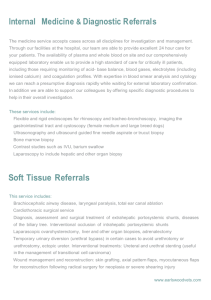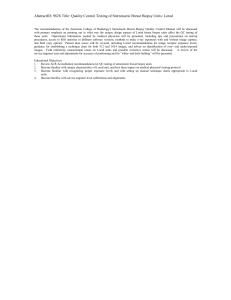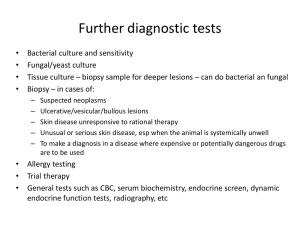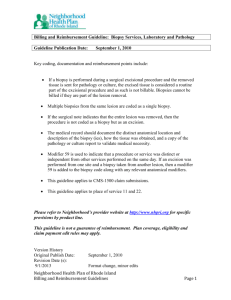Muscle or nerve biopsy - North Bristol NHS Trust
advertisement
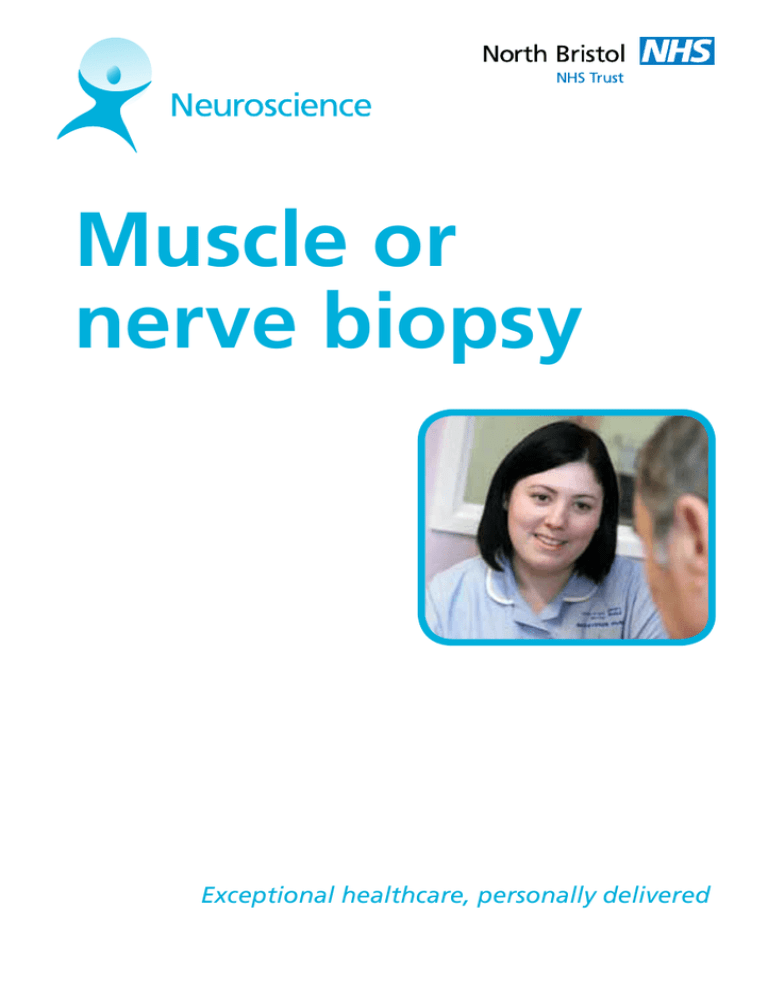
Muscle or nerve biopsy Exceptional healthcare, personally delivered Muscle or Nerve Biopsies What is a muscle or nerve biopsy? This is a small operation that involves taking a sample of muscle or nerve from under the skin to be tested in the laboratory. It will be performed under general anaesthesia. What is the purpose of the biopsy? Your doctors suspect that you may have a disorder affecting your muscles and/or your nerves, for which a cause has not been identified. The aim of the biopsy is to provide more information about the nature of this problem. The findings may help to decide whether treatment is likely to help your symptoms. How long will it take? The biopsy usually takes 15-30 minutes. You will need to come into hospital on the day before the operation. The anaesthetist and theatre staff will see you before your operation starts, and you will remain in the recovery room for the short while after the biopsy and before you are returned to the ward. You will spend the rest of the morning at the hospital and in some cases the staff may ask you to spend a longer time on the ward, possibly involving a further overnight stay, if they want to perform additional tests (for example, studies of nerve conduction). What happens to the biopsy sample? Samples are sent to the Neuropathology Department, where they undergo a number of special tests. These can take up to 6 weeks to complete, although the initial results of muscle biopsies are usually available within a week. The results will be sent to the Consultant who referred you for a biopsy. Eating and drinking As the biopsy will be performed under general anaesthesia, you will not be able to have anything to eat or drink for a period of time before the biopsy but will be free to eat and drink normally afterwards. The anaesthetist will advise you further on fasting times. 2 Muscle or Nerve Biopsy Medication You may take your medication as normal unless you are advised otherwise by the ward staff or anaesthetist. Please advise us immediately if you are taking any drug which alters the way your blood clots (including warfarin, aspirin, clopidogrel or any other anti-coagulant drug). If you are not sure, please ask your Consultant. Please also advise us if you are taking aspirin or any other anti-inflammatory medicine for pain. Muscle biopsies Where are muscle biopsies taken from? These are usually taken from the shoulder or thigh muscles. What are the main complications of muscle biopsies? There is likely to be some aching discomfort in the muscle for the first few days after the biopsy. In some patients this discomfort can take up to 2 weeks to disappear completely. Discomfort is less marked if you rest the muscles as much as possible, especially for the first 2-3 days after the biopsy. A physiotherapist may provide you with elbow crutches or a sling. You should take what you normally take for minor aches and pains, if necessary. There is a small risk of infection of, or bleeding into, the wound. There will be a scar at the site of the biopsy. This will initially be red but tends to fade and become less obvious in time. Nerve biopsies Where are nerve biopsies taken from? These are usually taken from the ankle. Muscle or Nerve Biopsy 3 What are the main complications of nerve biopsies? There is likely to be some discomfort at the biopsy site for the first few days after the biopsy. You should take what you normally take for minor aches and pains, if necessary. This usually settles but in about 1 in 10 patients there may be a persistent soreness at the site of the biopsy, which may last over a year. There will be a permanent area of numbness (loss of sensation) over the top of your foot in the area of skin supplied by the nerve that is to be biposied (the doctor will show you where this area is likely to be). A few days after the biopsy you may experience unpleasant sensations (pins and needles, burning, prickling, rawness) in the numb area, which disappears after about 3 weeks in most patients. However, in up to 1 in 3 patients these unpleasant sensations may persist for over a year. There is a small risk of infection, or of bleeding into, the wound. There will be a scar at the site of the biopsy. This will initially be red but tends to fade and become less obvious in time. Wound The operation site will be covered by a dressing. A crepe bandage may also be applied, to prevent excessive swelling. If you have had a biopsy from the ankle then you should keep this elevated and rest as much as possible for 2-3 days. You may remove the bandage after 2-3 days but should keep the dressing on for about a week, during which time you should try to keep it dry. Stitches Stitches may be of the soluble type or may need to be removed at your local doctor’s surgery. The person who will perform the biopsy will advise you what sort of stitches will be used in your case. 4 Muscle or Nerve Biopsy Going home You will need to arrange for someone to accompany you home from hospital. You will not be able to drive for several days after this procedure. Activity after surgery You will need to rest the limb as much as possible for the first few days after the biopsy. You should avoid driving for about a week or until the biopsy site feels comfortable. Follow-up Usually the Consultant who referred you for biopsy will see you again once the tests are complete. Problems If problems such as fresh bleeding or swelling occur in the first 24-48 hours after the biopsy has been performed ring hospital switchboard on 0117 950 5050 and ask to be transferred to the ward from which you were discharged. Alternatively, contact your GP. Muscle or Nerve Biopsy 5 References Deprez, M et al (2000) Nerve biopsy: indications and contribution to the diagnosis of peripheral neuropathy. The experience of the Born Bunge Foundation University of Antwerp and University of Liege between 1987 and 1997. Acta Neurologica Belgica, 100, 162-166. North Bristol NHS Trust (June 2003) Pre-Operative Fasting Protocol. Pearl, GS and Ghantak, NR (1995) Muscle biopsy. Archives of Pathology & Laboratory Medicine, 119, 303-309. Rappaport, WD et al (1993) Clinical Utilization and Complications of Sural Nerve Biopsy. American Journal of Surgery, 166, 252-266. Said, G (2002) Indications and usefulness of nerve biopsy. Archives of Neurology, 59, 1532-1535. Sources of further information Yahoo Health. Available at http://health.yahoo.com [accessed 25.2.05] Information on websites may change, North Bristol NHS Trust is not responsible for the content of websites referred to in this leaflet. 6 Muscle or Nerve Biopsy NHS Constitution. Information on your rights and responsibilities. Available at www.nhs.uk/aboutnhs/constitution Muscle or Nerve Biopsy 7 How to contact us: See your appointment letter for the number to phone with any queries you may have www.nbt.nhs.uk If you or the individual you are caring for need support reading this leaflet please ask a member of staff for advice. © North Bristol NHS Trust. This edition published May 2014. Review due May 2016. NBT002125

